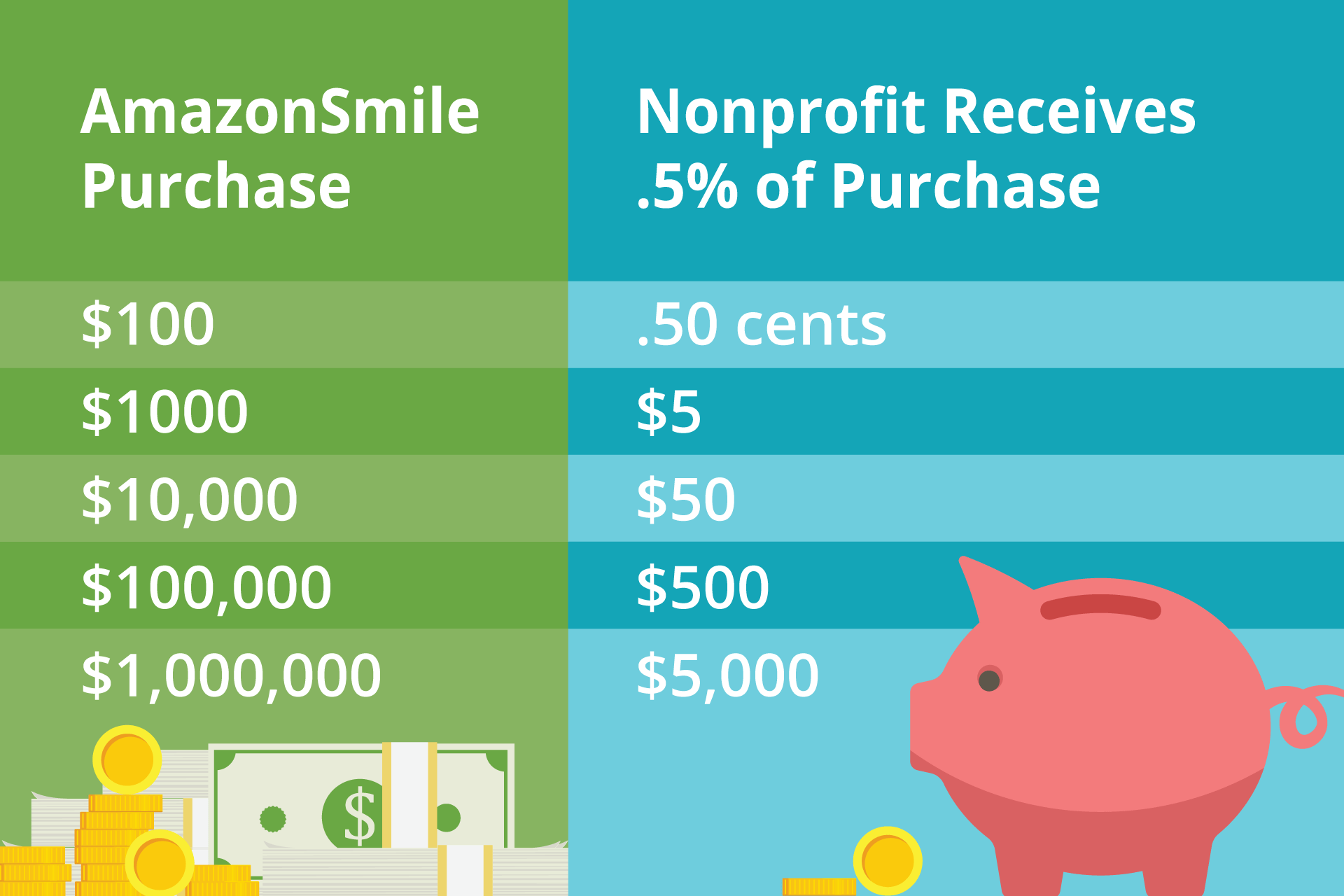By Frank Chezem
In the nonprofit world, monetary support received from individuals, corporations, foundations, and the government is crucial for organizations to carry out their mission. Several nonprofits I’ve worked with have asked about implementing an AmazonSmile, specifically for advice about marketing it to their members. If you’re unfamiliar with AmazonSmile, it’s a foundation that donates a small percentage of a shopper’s Amazon purchases to a designated charity. Is there a catch? Let’s take a look.
AmazonSmile does generate money for nonprofits, but only .5% of a shopper’s purchase is donated at the time of this writing. That means I need to spend $1,000 for Amazon to donate $5 to my favorite nonprofit. The spending chart below shows the steep purchase requirements to generate a meaningful donation.

After looking at those numbers, the conversation turns to: “Yeah, but what if we really market it to our members?” Well, anything is possible, but here are a few items to consider before signing up:
AmazonSmile may cannibalize other fund-raising
AmazonSmile can create a perception among your supporters that they’re providing meaningful support to their favorite nonprofit. For example, someone who spends $1,000 through AmazonSmile may think Amazon is donating more than $5. After all, they spent $1,000 on Amazon products so they may feel like they’ve done their part and decide to skip donating to their favorite nonprofit’s other fundraisers such as an annual appeal.
AmazonSmile doesn’t generate meaningful support
AmazonSmile only provides meaningful support with scale—huge, massive scale. Below are one-year AmazonSmile distributions to a nonprofit organization with an annual budget of $1.9 million:
- May 2016 $26.20
- August 2016 $14.23
- November 2016 $22.55
- February 2017 $15.27
The organization in the above example promoted AmazonSmile on their website, in a takeaway flyer, and periodically mentioned the program in social media and their e-newsletter. The result of their efforts was less than $80. I typically spend about $1,000 per year on Amazon products. Assuming that a nonprofit is, in fact, able to persuade 1,000 people with spending habits similar to mine to sign up, they’ll receive a more meaningful $5,000 from Amazon.
Promoting AmazonSmile is resource intensive
Back to the question: “What if we really market AmazonSmile?” Can the program provide meaningful support to nonprofits? It can if the organization persuades masses of people to buy Amazon products. Organizations should ask themselves “How much effort will it take to get all those people on board?” Consider staff resources for setup, promotion, and administration. An hour spent by a $25 / hour staffer isn’t offset until your AmazonSmile supporters spend $5,000 on Amazon products. Don’t forget to factor in the cost to produce marketing collateral. Spending $5 on in-house flyers (not counting staff time to design the flyer) isn’t offset until supporters spend $1,000 at Amazon.
AmazonSmile reduces spending in your community and may damage relationships with corporate supporters
Amazon is a commerce behemoth that competes with local businesses that sell books, electronics, groceries, healthcare products, sporting goods, and more. Amazon shopping is convenient (I admit that I’m an Amazon Prime two-day delivery addict), but it’s important to remember that every dollar spent with Amazon is not spent in one’s community.
Nonprofits risk alienating their local corporate supporters and community members when they promote purchasing Amazon products that could be bought locally. The “Amazon Effect” on the brick-and-mortar retail industry is extensively written about. Nonprofits should carefully weigh the cost and benefits and ask themselves this: Is Amazon going to sponsor our next community event or give to our annual fund?
Are there alternatives?
If you are wary of AmazonSmile, are there other strategies that offer a meaningful return on investment? Absolutely. Below are some tips for nonprofits looking to get the most return on their resources.
Google Ad Grants
Google gives nonprofits $10,000 of in-kind advertising every month. Nonprofits can use Google Ad Grants to share their story, draw individuals into their cause, recruit volunteers, and attract more members and donors. Google Ad Grants requires staff resources to implement, but what nonprofit wouldn’t benefit from $120,000 a year for digital marketing? The program offers meaningful value to nonprofits, and Google’s analytics provides a clear method to measure success.
Use resources to create content that builds affinity for your organization
If an annual appeal is your organization’s primary source of support, then consider spending your resources to create content that communicates your cause and reminds your members why they believe in what you do. Sharing stories of impact on social media and your blog are worthy of staff resources. Check out my blog for tips on how your teammates can contribute to your organization’s marketing efforts.
Remind donors that their contributions may be tax-deductible
AmazonSmile purchases are not tax-deductible, whereas contributions to a nonprofit organization are tax-deductible as allowed by law. Remind your donors they may be able to deduct the full value of cash donations to a 501(c)(3). Of course, they should always consult their financial adviser.
Wrap-up
Most nonprofits shouldn’t expect AmazonSmile to generate meaningful support. Through scale—massive scale—anything is possible, but most organizations will never realize meaningful support from AmazonSmile’s small .5% share.
AmazonSmile is a feel-good marketing initiative to ultimately sell more products. Amazon CEO Jeff Bezos states as much while talking about movies on the company’s Prime Video service: “When we win a Golden Globe, it helps us sell more shoes.”
At the end of the day, Amazon is all about selling you as much stuff as they can. It’s not too great a leap to conclude that AmazonSmile exists to sell more detergent than to generate meaningful monetary support for nonprofits.
 About the Author
About the Author
Frank Chezem specializes in visual and graphic design with more than ten years of experience creating clear, intuitive, and authentic solutions that help people and organizations achieve their goals. He loves collaborating with marketing and communication professionals, educators, publishers, subject matter experts, non-profits, and cultural organizations. Frank is dedicated to sharing his knowledge to improve products, support people's growth, and implement design processes for organizational success. When he's not percolating ideas, you'll likely find him enjoying the scenic outdoors with a camera in hand.